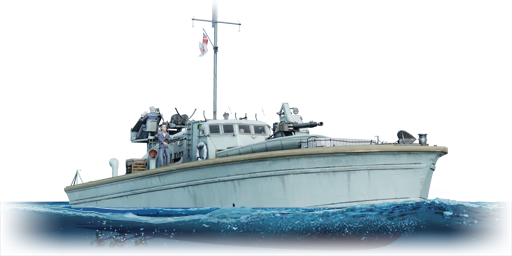

Coastal Fleet
MGB-75
II
Rank
AB
2.0
RB
2.3
Battle rating
Great Britain
Research country
Boat
Main role
1,000

Purchase

Premium vehicle
Status
General information
Specification
Armour
Hull
40 mm (wood)
Superstructure
15 mm (wood)
Number of sections
3
Displacement
52 t
Crew
12 persons
Max speed
Forward
786710477 km/h
Backward
22192921 km/h
Primary armament
40 mm 2pdr QF Mk.IIc automatic cannon
Ammunition
2,240 rounds
Belt capacity
56 rounds
Reload
basic crew → aces
7.8 → 6 s
Fire rate
200 shots/min
Vertical guidance
-5 / 70°
Turret Rotation Speed
Horizontal
40344034 °/s
Vertical
2521.32521.3 °/s
| Belt | Belt filling | Armor penetration (mm) at a distance: | |||||
|---|---|---|---|---|---|---|---|
| 10 m | 100 m | 500 m | 1000 m | 1500 m | 2000 m | ||
| HEF/AP-T/HEF/AP-T | 60 | 57 | 50 | 43 | 38 | 34 | |
| HEF/HEF/HEF/AP-T | 60 | 57 | 50 | 43 | 38 | 34 | |
| AP-T/AP-T/AP-T/HEF | 60 | 57 | 50 | 43 | 38 | 34 | |
Secondary armament
2 × 20 mm/70 Oerlikon Mark V autocannon
Ammunition
3,600 rounds
Belt capacity
60 rounds
Reload
basic crew → aces
10.4 → 8 s
Fire rate
450 shots/min
Vertical guidance
-10 / 70°
Turret Rotation Speed
Horizontal
60516051 °/s
Vertical
5042.55042.5 °/s
| Belt | Belt filling | Armor penetration (mm) at a distance: | |||||
|---|---|---|---|---|---|---|---|
| 10 m | 100 m | 500 m | 1000 m | 1500 m | 2000 m | ||
| HEF-T/HEF-I/AP-T | 34 | 32 | 26 | 21 | 18 | 16 | |
| AP-T/AP-T/AP-T/HEF-I | 34 | 32 | 26 | 21 | 18 | 16 | |
| HEF-T/HEF-I/AP-T/HEF-I | 34 | 32 | 26 | 21 | 18 | 16 | |
Anti-aircraft armament
2 × Turret — 2 × 7.72 mm Lewis machine gun, pattern 1916
Ammunition
7,760 rounds
Belt capacity
97 rounds
Reload
basic crew → aces
18.2 → 14 s
Fire rate
550 shots/min
Vertical guidance
-5 / 60°
Turret Rotation Speed
Horizontal
7563.87563.8 °/s
Vertical
7563.87563.8 °/s
| Belt | Belt filling | Armor penetration (mm) at a distance: | |||||
|---|---|---|---|---|---|---|---|
| 10 m | 100 m | 500 m | 1000 m | 1500 m | 2000 m | ||
| AP/T | 10 | 9 | 8 | 7 | 6 | 5 | |
Additional armament
Setup 1
2 × Mk.VII depth charge
Economy
Repair cost
AB
465 

RB
683 

Crew training
4,800 

Experts
32,000 

Aces
250 

Research Aces
440,000 

Reward multiplier
AB / RB
 2 x (65 / 85) %
2 x (65 / 85) % 
 2 x 124 %
2 x 124 % 

Premium vehicle
All modifications are unlocked
Seakeeping |
|---|
Unsinkability | |
|---|---|
Firepower | ||
|---|---|---|
Rating by players
You must play more than 3 battles for the last week and more than 10 battles in a vehicle to rate it.
Like:
7
Armor protection:
Not enough ratings
Survivability:
Not enough ratings
Mobility:
Not enough ratings
Armament:
Not enough ratings
Balance:
Not enough ratings
Tips & Tricks
This space is currently empty
Do you know any interesting vehicle features?
Loading...
No articles about this vehicle yet
Become the first author and get rewards!
Write a guide, tell about interesting historical facts, make a tutorial or simply an interesting post.
No more content